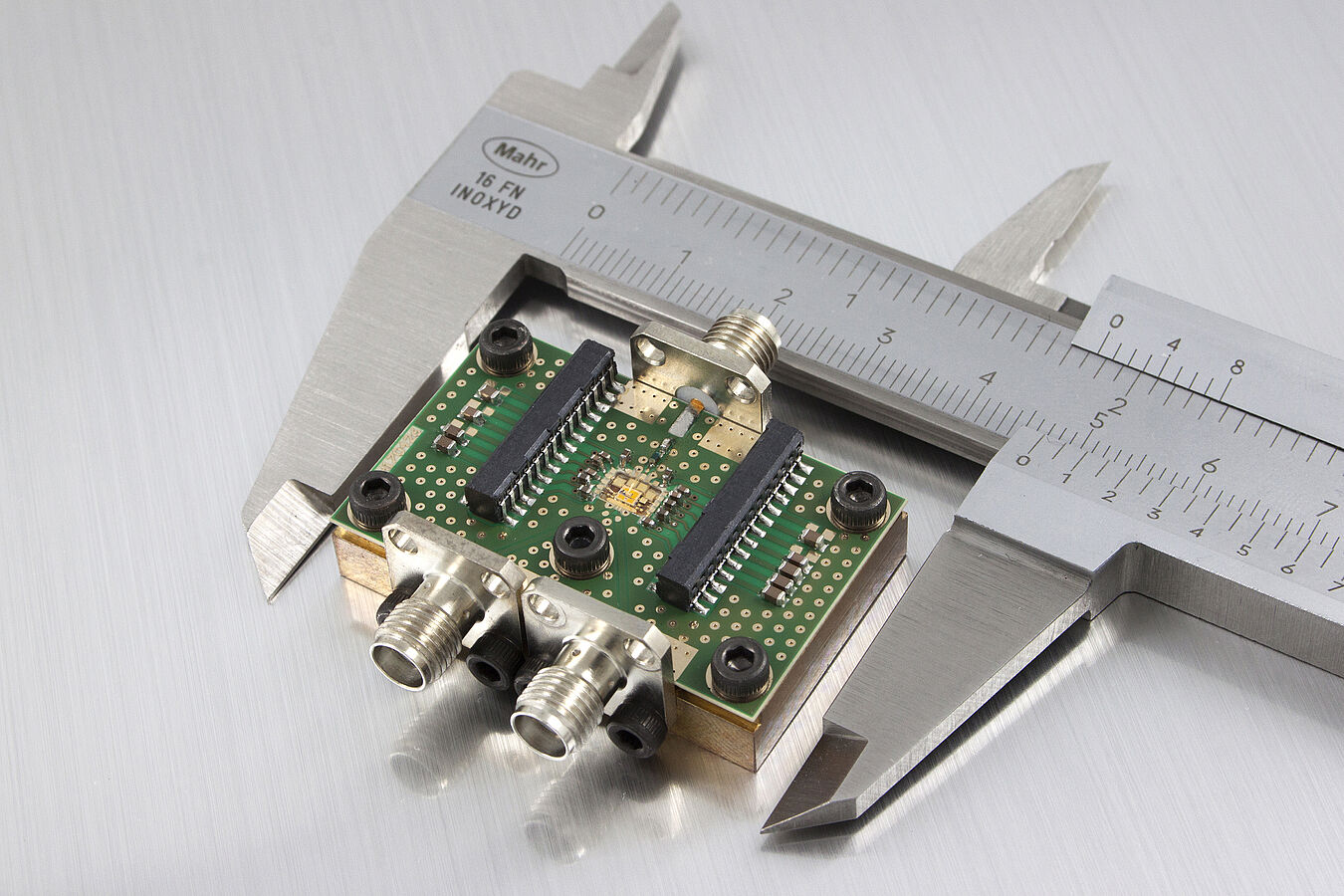Components for the digitization of mobile communications, for industrial and biomedical systems as well as for use in space.
The Ferdinand-Braun-Institut (FBH) will showcase a selection of current and new developments of its power amplifiers, circuits and heterointegrated chips at the EuMW in Paris. From September 29 to October 4, 2019 FBH will be present at the conference and exhibiting at the accompanying trade fair from October 1 - 3 at the joint booth B2200 of "Research Fab Microelectronics Germany" (FMD).
In addition to its components for 5G, space communications, and terahertz systems for imaging techniques, FBH will show a live demonstrator for pulsed laser sources. Using a particularly fast switching GaN-based driver, pulse length and intensity can be flexibly adjusted between 200 ps and 20 ns. The system can be flexibly equipped with laser diodes of various wavelengths (630 - 1180 nm). In LiDAR systems, for example, wavelength-stabilized laser diodes emitting at 905 nm with 100 watt peak output power and pulse widths of 3 - 10 ns are used.
Components for 5G and for satellite communications and sensors
Information and communication technologies account for 5% of global energy consumption – in the telecommunications sector alone, demand is rising by 10% each year. The projected 5G systems will use higher frequencies, thus enabling a larger signal bandwidth. FBH presents two approaches to improve their energy efficiency: a fully digital transmitter architecture and supply voltage modulation for linear amplifiers.
For future mobile communications, the institute is developing digital power amplifiers with efficient amplifier chips based on FBH's 0.25 µm GaN-HEMT process. With them, the institute has realized the first fully digital transmitter chain that successfully transmits broadband signals with maximum efficiency and linearity (47% at > 52 dB ACLR). The compact digital transmitter is particularly suitable for multi-antenna systems (massive MIMO) where it can be mounted on the rear side of the antenna.
As a second approach, systems are realized whose supply voltage is modulated and which are suitable for 5G and satellite communications. Their specialty is the efficient amplification of signals with high modulation bandwidths. Together with the European Space Agency ESA, FBH has developed a novel envelope tracking (ET) demonstrator for communication in space at 1.62 GHz. The amplifier has a peak output power of more than 90 W with a modulation bandwidth of 40 MHz. With an 8.6 PAPR signal, overall efficiency reaches 40%.
Concepts using modulated supply voltage are now also transferred to millimeter-wave amplifiers, which is an interesting option for 5G base stations. FBH has developed a corresponding module consisting of two identical MMICs connected in series. Each consists of a single-stage amplifier with an integrated two-stage voltage switch (class G). The module operates in the 20 - 26 GHz range with 14 dB gain and more than 2 W/mm at 20 V supply voltage.
For satellite sensors, FBH is also developing a modular MIMO radar at 85 - 95 GHz based on FBH's InP transfer-substrate DHBT process. The imaging radar will be used to locate and track objects in the vicinity of satellites. For this purpose, a complete chipset was developed and integrated into a module. The chipset uses novel MMICs with a high output power of > 15 dBm, a low noise figure NF < 9 dB and frequency converters down to the baseband.
Terahertz detectors and arrays for imaging systems
The terahertz (THz) range offers good spatial resolution and can penetrate most non-metallic materials. It is therefore suitable for a wide range of industrial and safety-relevant applications. However, there are still no imaging systems available with sufficiently high sensitivity and readout speed in this frequency range. Among other things, sensitive, fast and cost-effective THz detectors are missing that offer the potential to be used in THz cameras. FBH has successfully developed such detectors, which can easily be assembled into arrays. The III-V-based THz detectors offer superior values for the equivalent noise power NEP < 25 pW/sqrt(Hz) with a highest sensitivity of > 100 mA/W at 500 GHz. These values exceed the best THz detectors available in CMOS technology. It is now planned to develop THz cameras with similar values and an image refresh rate of more than 500 frames per second.


